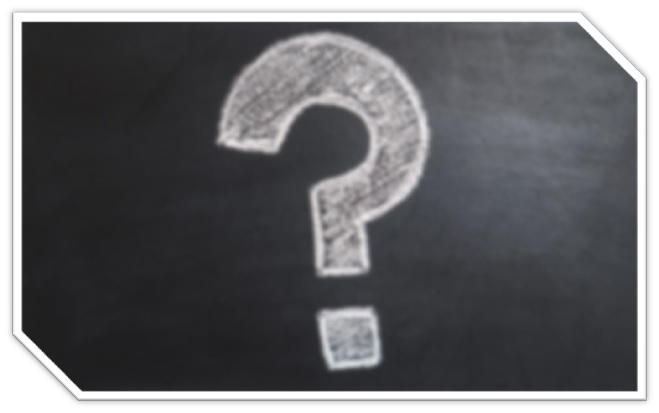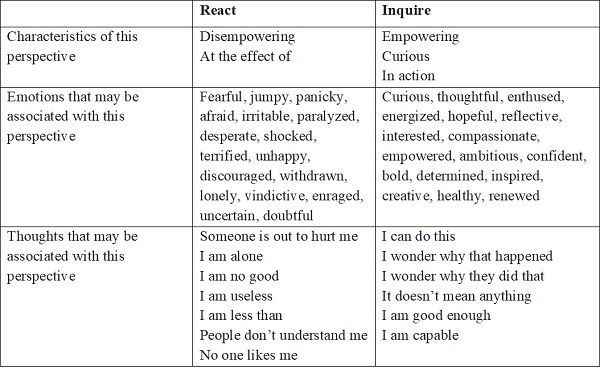 A Coaching Power Tool Created by Donna Horn
A Coaching Power Tool Created by Donna Horn
(Executive Coach, CANADA)
 My Tagline: People finding their power.
My Tagline: People finding their power.
My Mantra: Creating a space for people to see who they are and what they are capable of.
Introduction:
A power tool is a means for a coach to support a client to try on an empowering perspective on their problem or situation rather than a disempowering one. Using the tool is offered as an invitation to a client; the client can choose whether they wish to work with the tool in their coaching session.
The power tool I have developed for use in my coaching practice is called “Inquiring vs. Reacting”. I have found this shift in perspective has been effective for me at many times in my life and I wanted to develop it into a tool to be useful to others.
Explanation:
The Cambridge English dictionary[1] defines react as “to act in a particular way as a direct result of something else”. The nuances of the meaning are subtle, but in English, we understand this word to mean a somewhat involuntary or impulsive response to an action or situation. The involuntary nature of the response arises because our amygdala, or the lizard’s portion of our brain, is activated and we are triggered with an automatic physiological response to defend ourselves. This response is a stress response, an adaptation designed to keep us safe and alive in a dangerous situation. The response is sometimes referred to as the fight or flight response.
To react is to behave without forethought or intention. At times, this can be useful, such as when one reacts to a ball thrown at them by ducking or otherwise blocking the object. However, in most cases, we are reactionary beings and we would like to be more intentional and empowered in the responses we have. It is the inclination we can have to stay in reaction or to be triggered by a particular person or situation to be in reaction, that is troublesome for us. The react state is inherently fraught with stress, and it is not healthy for us to be in a stressed state any more than is necessary as we live our day to day lives. As well, when we are in an extremely emotional, reactive state, we do not have access to the rational[2] portions of our brains which are so important for living our best lives. Further, our brains are not able to distinguish the difference between something that is real and something that is imagined, which can exacerbate our reaction to a situation as we play it over and over in our minds.
Ideally, we would look at a situation and choose to create something that we can be in action around or move towards. This brings us to the other side of the power tool, which is to inquire.
To inquire is a verb that is defined in the Cambridge English Dictionary[3]as meaning ‘to ask for information’. Inquiry involves curiosity and listening. Curiosity was defined by William James[4] as “the impulse towards better cognition,” meaning that it is the desire to understand what you know that you do not. It is a powerful state in which we are being curious about the situation, the person, the occurrence. Doesn’t this sound more empowering than react? The inquiry includes clarifying what the facts and perspectives are in a situation and what you might have control over and what you do not.
Application:
When a client is suffering emotionally or mentally about something that happened, they are stuck in a state of reaction. They are ‘at the effect of’ whatever the thing that happened. It might have been an action that someone else took, it might have been something that was said, it might have been an outcome from action the client took that was not expected and not welcome.
The client’s upset is held in place in this reactionary mode. For the client to be able to be okay with what happened, it is useful for them to shift to a different perspective about what happened. To let it go or let it be, and reach a state of equilibrium, from which they can then create something. Access to letting go of the reactionary state to a state of power is through inquiry and curiosity.

Application in coaching can be a valuable and important shift in perspective for the client. A client enters a session and tells you a story about a recent incident or conversation where they had a strong and negative reaction. They may still be in that state of reaction, and they might be experiencing stress and a disempowering perspective around the incident. They want your support as their coach, for example, to understand what their state is or to move beyond it to a place that feels better. As a coach, and with their permission, you can work with them to shift their perspective from this disempowering one to one that is of inquiry and empowerment. Questions that might be appropriate depending on the context are as follows:
These questions can initiate an exploration of the client’s current perspective and support them in shifting to a perspective that feels better, empowering, and enables them to move forward from the reactionary state.
Reflection:
So many life situations support an initial reaction in us and others that is one of blaming or seeing ourselves as a victim. It is sometimes a natural tendency to stay stuck in this mode and to want to make someone else responsible for our negative experience of a situation or of a relationship. I am a moderator of a positive co-parenting group on a social media platform, and I see how often people cling to this perspective of reaction, of blame, of lack of responsibility. It feels good to be vindicated, it feels good to have others exclaim about how badly you were treated. However, there is no power there, and no ability to move forward, and no ability to create something good. It is therefore so helpful to support another, whether a friend or a coaching client, to try on a lens of inquiry. What is true about the perspective that you are bringing? What might not be true? What is another way to look at this situation that could be equally true? Byron Katie’s work and her four questions[5] are largely constructed around this lens:
- Is it true?
- Can you absolutely know that it’s true?
- How do you react when you believe that thought?
- Who would you be without the thought?
Regardless of fault, regardless of the initial reaction to a situation, there is something else possible and accessible. Beyond that, something else is a powerful state and one that enables you to let go and move forward and have a lens of greater compassion and acceptance to others in your life. This power tool “Inquiring vs. Reacting” can give you that access.
References:
Stock Photo on Cover: Photo by Jessica Lewis from Pexels
React vs. Respond What is the difference? Psychology Today, September 1, 2016
Fight or Flight Response, Information Handout. Psychology Tools, 2020
List of Emotions, Lexi Schmidt, March 2, 2017, The Growlery
List of Emotions, Emotions Word List, English Study Here
The Psychology and Neuroscience of Curiosity, Celeste Kidd and Benjamin Y. Hayden*, US National Library of Medicine
The Work of Byron Katie, Four Liberating Questions, Tom Moon, MFT
Amygdala Hijack: When Emotion Takes Over, HealthLine
[1]https://dictionary.cambridge.org/dictionary/english/react.
[2]https://www.healthline.com/health/stress/amygdala-hijack#overview
[3]https://dictionary.cambridge.org/dictionary/english/inquire
[4]James W. The principles of psychology. 1913; II